Did the @usgamuseum forget it held the 24th Amateur Public Links Championship in 1949 at the new Rancho Golf Course? The opening of the new L.A. Parks links by Bill Johnson & Billy Bell replaced Herbert Fowler's 1921 Ambassador/Rancho links. @usopengolf https://t.co/CIcpyvSf1G
— Golf Historical Society (@GolfHistorical) June 5, 2023
Category: Rancho Park Golf Club
Robert “Bob” Lunn at Rancho Park
In 1971, the 45th Los Angeles Open was renamed the Glen Campbell Los Angeles Open.
According to course manager Si Wasserman, the Rancho Golf Course was in the middle of $300,000 worth of major improvements. Tee’s were enlarged and re-seeded; a new driving range fence was installed with sound baffles; and six new “sand traps” were added “to make an already difficult course even more challenging,” and the Rancho restaurant was renovated to be “on a par with the finest of any public facility.”
“Some 70 palm “trees” have been placed at strategic spots to improve the landscaping. Hundreds of young trees have been planted at appropriate locations to provide a beautiful background.”
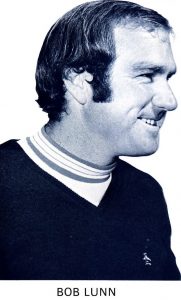
San Francisco municipal golfer Robert “Bob” Lunn had missed a playoff with Billy Casper and Hale Irwin in the 1970 L.A. Open by one stroke and was ready for another chance in 1971. Coincidentally, Lunn won the USGA Public Links championship in 1963, the same “major” that Rancho had hosted for its grand opening in 1949.
Note: For all professional golf competitions at Rancho Park the nine’s were reversed.
From the 1972 Glen Campbell Los Angeles Open Press Book:
RESUME OF THE 1971 LOS ANGELES OPEN
The tradition-rich Los Angeles Open has seen surprisingly few playoffs during its 45 years. But the law of averages has begun to catch up in the last three years, each of which produced a sudden-death playoff.In 1971, Bill Casper, who won such a decider from young Hale Irwin in 1970, lost out to husky Bob Lunn in a tense, four-hole playoff.
Lunn 25, and the veteran Casper, 39, tied at the end of the regulation 72 holes with eight-under-par 274s. Veteran Art Wall almost made it a three-way playoff but three-putted the 72nd hole to finish one shot back of Lunn and Casper.
The Lunn-Casper playoff started on the 15th hole and they battled all the way to the 18th before a decision was reached. There, Lunn put his approach shot 18 inches from the flag while Casper was on the back of the green.
Billy made a good attempt for his birdie but just failed. Lunn then rolled in the putt to take the $22,000 first prize and another big step in his career.
(From the 1972 L.A. Open Press Book.)
The 1971 Open was close and competitive all the way. Virtually unknown Bobby Greenwood led by three shots entering the final 18 but couldn’t handle the pressure and slipped to a 73, which netted him a tie for fourth place.
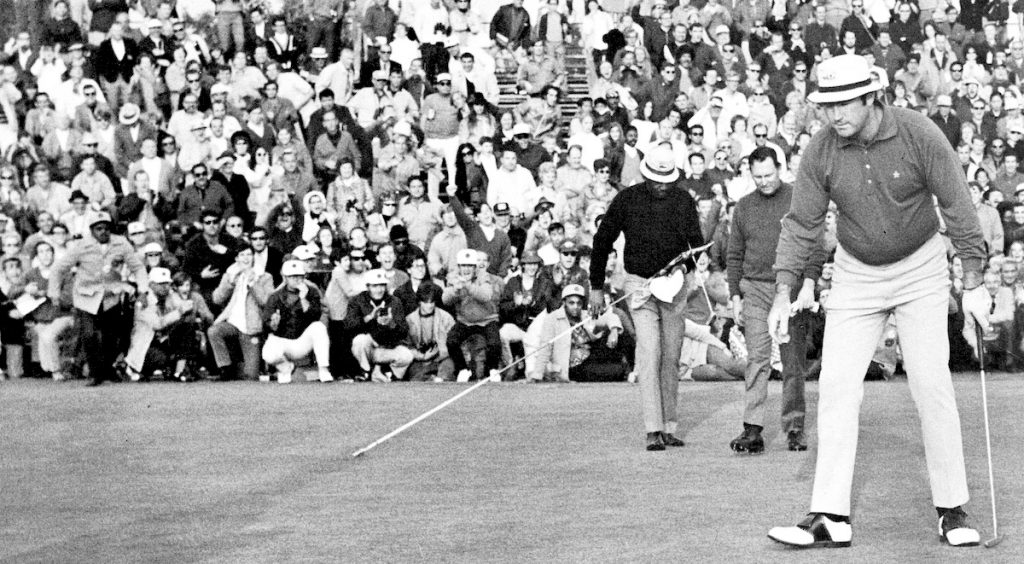
Here is Bob Lunn’s story by Shav Glick, from the 1972 L.A. Open program:
BOB LUNN – DEFENDING CHAMPION
At first glance Bob Lunn appears to be a big, burley fellow who could pass for the town bully in a “B” Western.
But he’s really as emotional as a puppy.
Bob’s first win on a golf course came when he was an 18-year old public links golfer from Sacramento. He won the 1963 U.S. Public Links championship on the Haggin Oaks Course in his hometown, defeating Steve Opperman, 1 up, in the finals.
“When that last little putt dropped into the cup,” said Lunn, I couldn’t keep the tears back. And l thought I was going to be sick.”
A few years later he was making $100,000, on the PGA tour, but he hadn’t lost his sentimental altitude.
Last January, after defeating defending champion Billy Casper in a sudden-death playoff for the Glen Campbell Los Angeles Open here at Rancho Park, he was the same old Bob Lunn, a little older and a little bigger, but still the same.
“I’m so happy I could cry – and I probably will,” he said as he accepted a check for $22,000 from Los Angeles Junior Chamber of Commerce officials.
Lunn’s entry into professional golf was as uneventful as his high school career when he didn’t win a tournament. In his first year, 1967, he played in 27 events and won only $1,871 in “official” money. However, he picked up a nice “unofficial” check for $ 6,660 when he teamed with another rookie Rich Martinez of San Clemente to finish second in the Haig and Haig Scotch Foursome tournament.
His success in the November Haig and Haig at La Costa carried over into 1968 when Lunn soared into the $ 100,000 bracket and, was selected by Golf Digest as the “most improved professional of the year.” Bob started off with a fourth place finish in the Andy Williams San Diego Open, worth $7,500, but he won money in only three of his first 12 tournaments. Then, in May, he won back-to-back tour victories at Memphis and Atlanta, becoming the first player in history to follow his initial tour victory with another the following week.
Buoyed with confidence from his fine sophomore year, Lunn started 1969 by winning the $ 31,000 Southern California Open at Los Coyotes. It was the start of another big year for the big fellow from Sacramento. In 1970 he earned $101,685, his second year over the hundred thousand figure.
During the Glen Campbell L.A. Open last year Lunn decided that too much of his earnings were going to his waistline. He had ballooned to 240 pounds during the holiday season and he felt a diet was necessary.
“The extra weight didn’t hurt my game in any way that l could tell,” said Lunn, “but l figured I didn’t need it. l was afraid from a health standpoint.”
Lunn lost 10 pounds during the four rounds here at Rancho and decided that, as long as he won the tournament, he would lose some more. Pretty soon it developed into an obsession and by mid-April he was down to 175 pounds.
“While I didn’t notice any appreciable change in my game, I couldn’t relax off the course,” he admitted later. His wife, a beautiful brunette named Angie, noticed the difference. “He’s too quick to snap at little things.” she confided. “He’s just not like himself .”
When things go wrong for Lunn he turns to Tom LoPresti, the man who gave him his start as a professional, backing him to the tune of $ 250 a week during the early years.
Lunn called LoPresti in Sacramento when the tour reached Atlanta and Tom, a former pro himself, flew to Georgia to help straighten him out.
“After I played one round with Bob I knew his game had gone to pot. He wasn’t consistent off the tee, he shanked some shots and he couldn’t concentrate at all on the greens. I figured he’d lost too much weight too fast and I talked him out of his diet. I convinced him to start eating again, especially foods heavy in dextrose and protein.”
Now Bob is back up close to the 200 pound mark again and hitting the ball with his high, wide and handsome swing. He finished second in the Heritage Golf Classic last month to lift his earnings to $ 82,179 for 1971.
Lunn has had little difficulty preparing himself for defense of the Glen Campbell Los Angeles Open. He is one who loves to practice.
“When l’m not in a tournament I play only about 18 holes a week, but I try to get in at least two hours of practice every day,” he once said. “That’s just as much fun as playing. I love to just stand there and hit those balls.”
He hits them a long way, too. In a stretch of 21 tournaments where IBM charted every drive of every professional, Lunn averaged 268 yards. Only DeWitt Weaver, Jack Nicklaus and Marty Fleckman were longer.
Now that Bob’s weight is back up, there’s very little to distinguish him from the young fellow who started out on the tour six years ago – except his bankroll. Once Bob was asked what difference success had made to him.
“It’s funny, the other guys are letting me tell my stories now. They used to bore me with their own,” he answered.
If he can win the Glen Campbell Los Angeles Open again this week he’ll have a whole lot more to talk about. No one has scored back-to-back wins in this tournament since Arnold Palmer accomplished the feat in 1966-67.
And if he does, he’ll probably cry, too.
Shav Glick, from the 1972 L.A. Open program
©2022 Jib Jones golfhistoricalsociety
GO GOLF – A Vote For Faster Golf, by Ray Goates, Golf Manager, Rec. and Parks, L.A.
From the 43rd L.A. OPEN program. 1969 Los Angeles.
1969-43rd-LA-OPEN-program-Go-GolfArnie Palmer and his infamous 12
by J.I.B. Jones
February 9, 2021
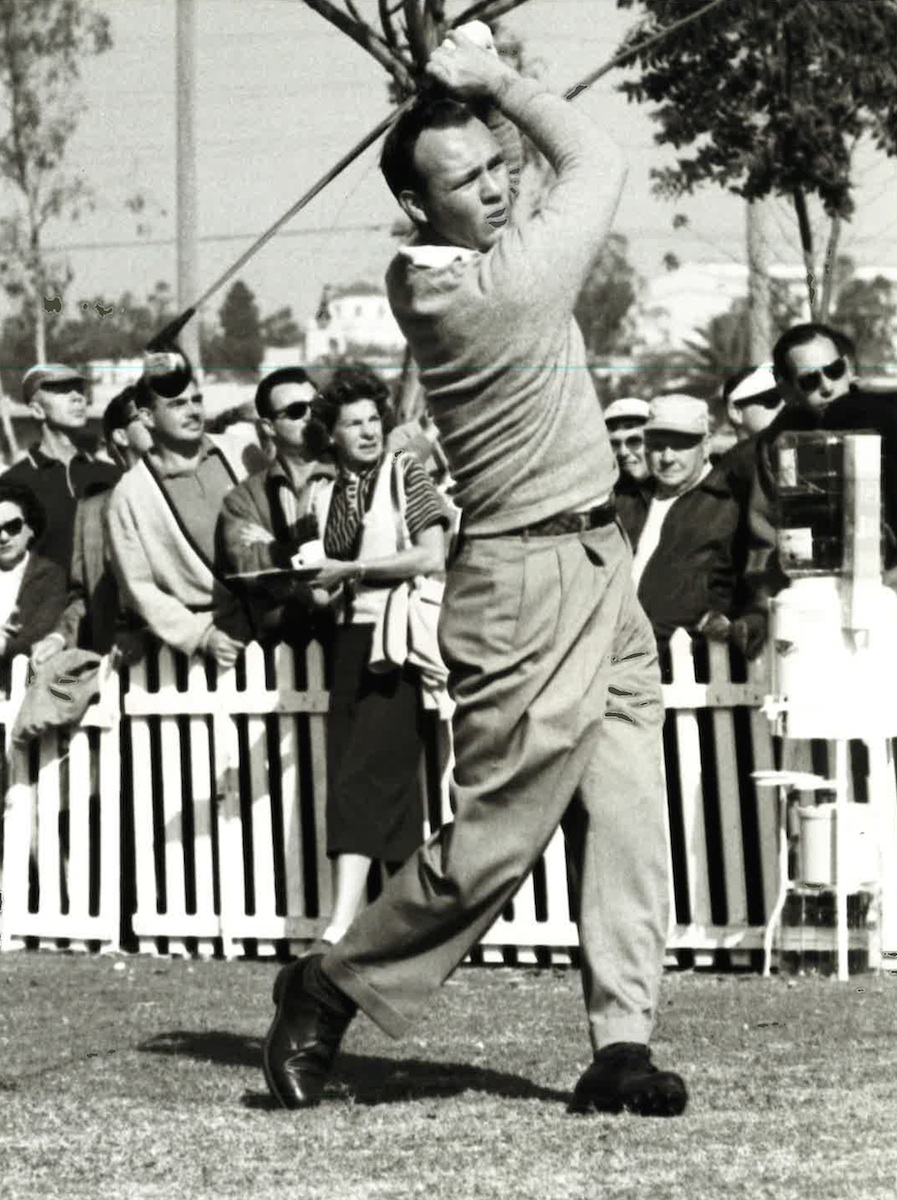
Today we’re looking back 60-years to the 35th Los Angeles Open at Rancho Municipal Golf Course and remembering the 12 that shook the world! The one scored by the late great, handsome, swashbuckling golfer, Arnold Palmer, on his 18th hole of the 1961 tournament.
I also want to share with you how Arnie’s story has been remembered over the years, so, after the “overview” you will find selected quotes from various news sources describing how he got the 12. Arnold himself was asked about it more than a few too many times!
Overview
The 35th Los Angeles Open (“Golf’s Golden Tournament”) was presented by the L.A. Junior Chamber of Commerce and the Southern California Professional Golfers Association. The Rancho Municipal Golf Course measured 7,131 yards and was a “par” 71. The professionals played the course with the front and back nine’s reversed, starting at the regular 10th hole. And like today, some players started on the 1st, and some on the 10th. Also traditional at Rancho for the Los Angeles Open, the Open was played from Friday to Monday. Thursday was Pro-Am day. Television forced the Thursday-Sunday change in 1966.
Interestingly Arnold Palmer “tee’d off” on the 10th, the regular 1st hole, on Friday at 12:14 P.M., playing with Billy Casper (71) and Bo Wininger (74). When he reached the 508 yard par-5 eighteenth hole he needed “par” to finish one-under 70 and stay in contention, but he spoiled it.
Palmer’s drive was perfect and went 270 yards to the middle of the fairway, leaving him a 238 yard uphill shot to a raised green at the end of a 50 yard-wide funnel of “Out of Bounds” fences.
For his second and fourth shots Arnie hit over the 25 foot high driving range fence on the right, and then put his 6th and 8th shots into the middle of Patricia Avenue on the left, with one ball crossing Pico Boulevard. For his 10th stroke he ended up over the flag on the apron of the green on a downhill lie. His approach was short, and his one-putt earned him the 12, scoring 77 for the round. It put him 10-strokes behind the leader Ted Kroll, and led to him missing his only cut of the year by one stroke when he scored 72 in Saturday’s second round.
After the L.A. Open Arnie sped off to San Diego and won the tournament, followed by wins at Phoenix, Baton Rouge, Texas, and topping off his summer by winning the Open Championship at Royal Birkdale in England.
The Stories
1961 01 07 – LA Times – Dick Hyland says: R, R, L, L
“Palmer took a 3-wood and swung. The ball shot straight as an arrow, high and to his right – six feet out of bounds over the 25 foot fence guarding the driving range.
Palmer dropped a ball, swung again. Again out of bounds. Same place.
Again he dropped a ball. Palmer corrected his grip and stance. Overcorrected. Bang. Out of bounds again, this time hole high over the grandstand and 30-ft high fence bordering Patricia Ave.
Palmer did not hesitate. He dropped another ball over his shoulder, stepped back, addressed the ball – and hit it out of bounds behind the stands again!
The fifth ball he played on the hole, for his 10th shot, Palmer slapped past the pin onto the green, the first player to hit past the pin on the long hole all day. The ball trickled a foot off the far side of the green onto the apron 25 ft. from the pin. Palmer finally went into the cup with his 12th stroke.
‘A nice round number.’ he mumbled writing it on the card. The crowd cheered him loudly.
‘What were you trying to do?’
‘I was just trying to get the ball on the green.’
‘What happened?’
‘I just hit some bad shots.’ “
1961 01 07 – LA Times – Paul Zimmerman says: R, R, L, L
“He pushed his first fairway shot over the fence into the driving range. The second went the same place, as Arnold struck with his No. 3 wood.
Boom! went the third high over the screen onto Patricia Ave., as he hooked badly trying to adjust. The fourth one looped into the same place and rolled to Pico.
‘What were you trying to do?‘ someone asked naively.
‘I was just trying to get the ball on the green,‘ was Palmer’s retort as a thin grin broke across his handsome face.“
1961 01 07 – NYT – Arnold Palmer Says: R, R, L, L
“ ‘I pushed a No. 3 wood out of bounds into the practice fairway the first time. Then I pushed another one about in the same spot.‘
‘It is possible I over corrected on the third one and knocked that clear out of the course on the opposite side of the fairways and clear out on the highway. The fourth one went right with it.‘
‘It was a nice round figure, that 12,‘ he quipped as he walked off the El Rancho course, appearing only slightly perturbed.”
1965 01 07 – LA Times – Bill Shirley says: L, R, L, R
“He knocked his second shot out of bounds to the left, dropped another ball and hit it out of bounds to the right…He tried again – and hit another shot out of bounds to the left. Shot No. 5 sailed out of bounds, this time to the right again, presumably to keep the score even.”
1967 01 27 – LA Times – Charles Maher says: L, R, L, R
“On his second shot…Palmer hit a ball right down the middle. That is, it was right down the middle of Patricia Avenue, which borders the course on the west.
Palmer then shot out of bounds on the east side, knocked another ball onto Patricia Avenue, went out of bounds once more in the east…”
1968 01 21 – LA Times – Patrick McNulty says: L, R, L, R
“Palmer blasted off with another power shot that carried 250 yards. Unfortunately, the shot hooked badly, finally bouncing out of bounds on the road.
Then: Whammo! another Palmer shot, this time slicing over into the driving range…dropped another ball. Incredibly this ball too began curving left, falling into the street…Another ball and another slice…”
1982 01 13 – UPI – Plaque says: R, R, L, L. – Palmer says: R, L, L, R
“A permanent plaque describes the 12 as follows: After hitting a perfect drive, Palmer sliced two balls into the driving range and followed with two hooks onto Patricia Avenue, which runs alongside the ninth fairway. He reached the green with his 10th shot and two-putted for his 12.
Palmer, understandably, says he doesn’t remember all the details of the fateful day in the first round of the 1961 tournament. But he said the plaque is wrong.
‘After a pretty good drive, my next shot, a 3-wood, hit the top of the fence before going into the driving range,’ he said. ‘Then my next shot hooked over the fence. I think my next shot went left, too, then the next one went to the driving range again.’ “
1983 01 13 – LA Times – Shav Glick – two right, two left
Palmer – “ ‘The plaque is wrong, though, it wasn’t the first round, it was the second round.’ “
1987 07 18 – Washington Post – Arnold Palmer says: L, R, L, R.
“I took 12 on a par-5 in the L.A. Open once: I wanted to knock a 3-wood on the green, but put it out of bounds to the left. I hit it again and put it out of bounds on the right. Then the left again, and then the right again. A guy in the press asked me, `How’d you make 12?’ {Pause. Wink.} I said I missed a 20-foot putt for 11.”
1990 10 25 – LA Times – Dan Hafner – Palmer says: R, L, R, L.?
“It was Palmer’s last hole of the second round on Jan. 6, 1961. He drove the ball 275 yards up the middle of the fairway.
‘The plaque says it was the first round, but it was the second,‘ Palmer recalled. ‘I knew that I needed a birdie for a 68, and an eagle would put me close to the lead.‘
‘I went for the green in two, using a three-wood. It soared over the fence into the driving range.’
Asked why he didn’t then play it safe, Palmer said, ‘Well, I still had a chance to make par.’
Palmer hit the next shot into the road on the left, then stubbornly hit two more out of bounds.
‘I had to make a tough putt just to get my 12,’ he said, laughing. ‘Instead of being close to the lead, I missed the cut.’
‘I think you could say there was no lasting effect. I won the next two tournaments on the tour and then had three winning tournaments at Rancho in future years. I’ve always enjoyed playing there.’ “
1991 04 07 – LA Times – Mal Florence – Palmer says: 4 balls out of bounds
“He then proceeded to hit four balls out of bounds and missed the cut.
‘I was devastated,’ he said. ‘I went to the VIP tent and ordered a beer. I was mulling over what happened, and J. Paul Getty was in there and he said. ‘How in the world could a player of your caliber do that?’ I said, ‘Well, I missed a 20-foot putt for an 11.’ ”
1993 10 17 – OC Register – John Strege – Palmer says: R, R, L, L
“Palmer put his drive in the fairway, then pushed his next two shots right, into the driving range. He hooked two shots out of bounds, onto Patricia Ave. He then hit the green and took two putts.
Later he was asked how he made 12.
‘I missed a three-footer for 11,’ he said.”
2014 05 08 – TV Week – Chuck Ross – Palmers says: R, R, L, L
“ ‘…pushed the first two shots – hooked two onto road.’ ”
Arnie Palmer and his infamous 12 by J.I.B. Jones
©2021 JIBJONES Golf Historical Society
71 Years of the Rancho Park Golf Course!
Rancho Municipal Golf Course opened on July 3, 1949, with a Bob Hope exhibition, followed by the U.S.G.A. Public Links championship, and has continued to host numerous golf championships on its hallow green ever since.
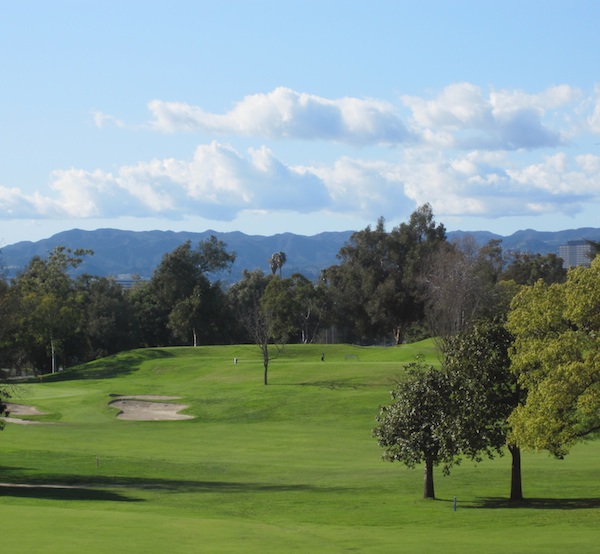
Always one of the busiest golf courses in America, Rancho’s rolling hills, lofted trees, wide fairways, minimal rough and small greens, can still challenge and enchant, despite existing in a playing condition more akin to the 1980s than television golf.
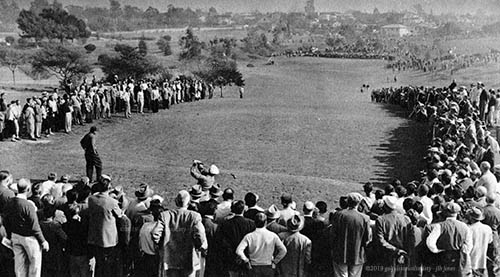
The Los Angeles Open was held at Rancho between 1956 and 1983, when it was a major civic event, drawing thousands of spectators, and where Arnie’s Army really began.
The Open’s early-January date was the first of the professional season, and often enhanced by fog, wind, cold and rain, making for great competition. When Rancho was in championship form, with double cut greens, deep rough and narrow fairways, the pros almost never “ate up” the course.
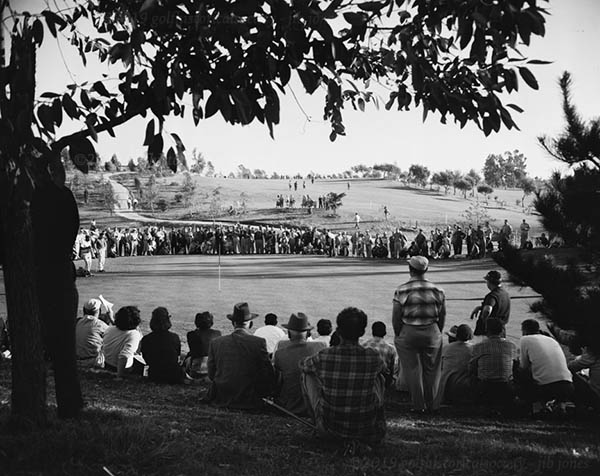
The lowest Los Angeles Open score on Rancho was 268 by 23 year-old Phil Rodgers in 1962, the same year Jack Nicklaus entered his first championship and finished in last place. Rodgers had a 62 in the final round! Phil also won the 1954 Junior L.A. Open at Rancho, beating runner-up and National Junior champion Al Geiberger by seven strokes.
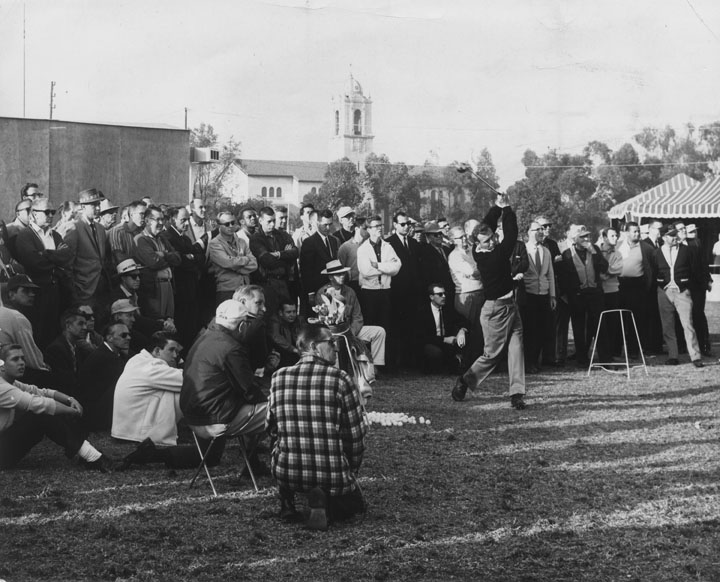
Rancho’s next lowest L.A. Open score was Arnold Palmer‘s 269 in 1967.
Gil Morgan managed 270 in the last L.A. Open at Rancho in 1983. This compares to Lanny Watkins’s record score of 264 in 1985, Fred Couples’ 266 in 1990, and Chip Beck and Mike Weir’s 267 in 1988 and 2004 respectively, all scored on the Riviera Country Club course.
Happy 71st Birthday Rancho!
©2019 golfhistoricalsociety – jibjones – All Rights Reserved.
Rancho Golf Course – July 17, 1949
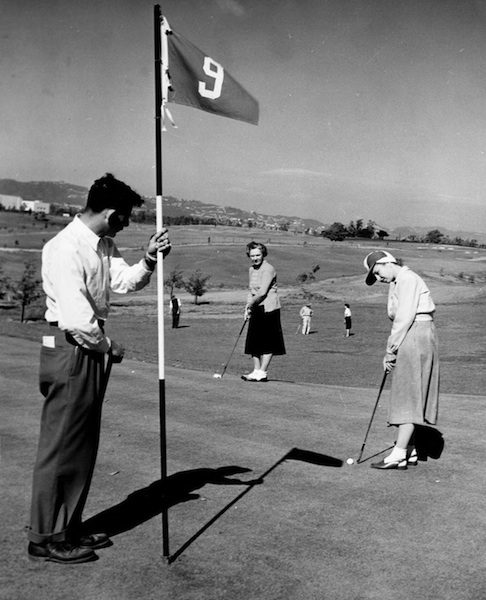
After the Bob Hope Exhibition on July 3, followed by the United States Golf Association Public Links championship, the Rancho golf course opened to the Public on July 17, 1949. Greens fees were $1 for 18 holes!
The Los Angeles Times reported that,
“A capacity play of 400 golfers crowded the new Rancho municipal course yesterday on the first day of public use of the city’s latest 18-hole links.”
“From 4:40 a.m., when the clubhouse doors were open and several score early waitees headed for the starter’s window, until 6 o’clock when the place was jumping. By 7 a.m. a four-hour wait was needed to get a starting time at the first tee.”
“Weekday play at Rancho will start at 6 a.m.”
©2019 golfhistoricalsociety and jibjones All Rights Reserved.
57th L.A. Open at Rancho Park, Los Angeles
In 1983, the 57th Glen Campbell Los Angeles Open returned to the 6638-yard Rancho Park Golf Course for one year, while Riviera Country Club hosted the PGA Championship.
The L.A. Open was played at Rancho from 1955 to 1972 (minus 1968 at Brookside Park), and most recently in 1983. The Rancho golf course has been home to three permanent golf clubs, and more than 100,000 local and visiting golfers, every year, since 1949. The excitement level of having the professionals at Rancho was always high, with so many of the spectators knowing the course from first hand experience, and the tournament having the full support of the community, and the city of Los Angeles, it isn’t hard to imagine that L.A. Open’s at Rancho were a big success!
In 1983, the pro-amateur featured former U.S. President Gerald Ford, Jack Lemmon, Fred MacMurray, Mike Douglas, Robert Stack, Monty Hall, Dick Martin, Johnny Mathis, Foster Brooks, Scatman Crothers, Wayne Rodgers, Tommy Lasorda, and Steve Garvey, who all entertained the fans.
The professional competition included, Tom Watson, Arnold Palmer, Johnny Miller, Craig Stadler, Dave Stockton, Jim Dent, Lee Trevino, Payne Stewart, Roger Dunn, Charlie Sifford, Jim Thorpe, Bobby Clampett, Roger Maltbie, Larry Mize, Bobbie Wadkins, Fuzzy Zoeller, Mac O’Grady, and others.
53-year old Arnold Palmer opened with a 66, and even led for five holes during the final round! Nowhere on tour has Arnie had more love and support than from his fans at Rancho! And he always deserved it!
Gil Morgan won the title, his second LA Open, scoring 270 over 72 holes.
Previous LA Open winner at Rancho, George Archer, scored a record 61 in the third round, making back to back eagles on No. 8 and 9 (#17 & #18).
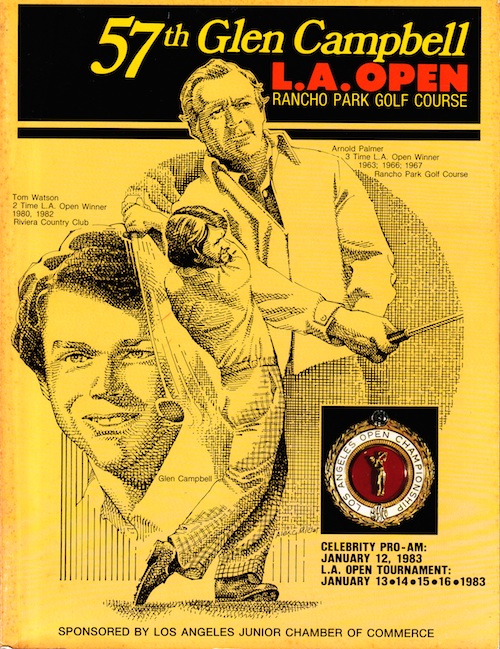
Rancho Municipal Golf Course Opening Exhibition, July 3, 1949
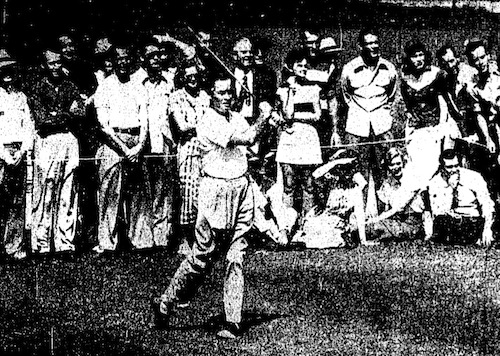
Over 2500 fans turned out to see Bob Hope and Johnny Dawson lose their match to George Von Elm and Bruce McCormick at the opening of the city of Los Angeles’s new Rancho Municipal Golf Course on July 3, 1949.
According to the press, Hope was beaten, but not silenced!
Johnny Dawson and George Von Elm were advisors to William “Bill” Johnson and William P. “Billy” Bell in the design and construction of the new championship golf course, and the Nine hole Par 3 course. Both layouts were built on the site of W. Herbert Fowler’s 1921-1944, Hotel Ambassador/Rancho Golf Club course.
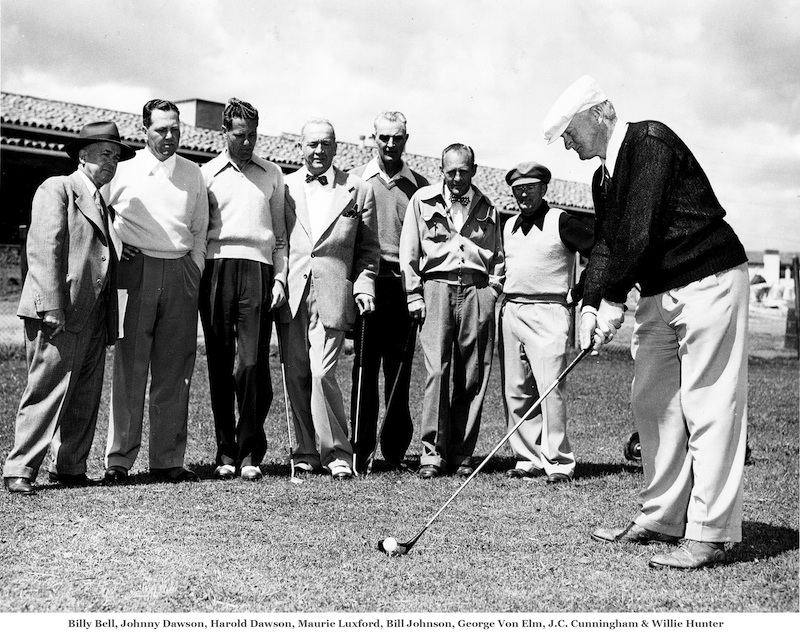
The most historic photo ever taken of Southern California legends!
Bell designed and built over 60 golf courses in California, Arizona and Hawaii.
Dawson a 5-time So Cal Amateur champion, course architect, and 1949 U.S. Walker Cup Team.
McCormick was 1937 U.S. Amateur Public Links, twice Cal State, three time So Cal Amateur champion, and 1949 Walker Cup Team.
Luxford was the Father of Celebrity golf, ran Crosby’s Clambake, S.C.G.A. President, L.A. Open fundraiser, and President of the L.A. Recreation and Parks Commission.
Johnson worked for Bell as Greenkeeper at: Royal Palms, L.A. Rec. and Parks Griffith Park, Architect with Bell and Billy Bell Junior.
Von Elm was multiple So Cal, Cal State, Trans Mississippi amateur champion. He beat his 1926 U.S. Walker Cup team mate, Bobby Jones, to win the 1926 U.S. Amateur, while playing for the Rancho Golf Club!
Hunter was the son of Henry Hunter, Royal Cinque Ports Greenkeeper/Professional, and nephew of Ramsey Hunter, designer of Royal St. Georges. He was 1921 British Amateur champion. Rancho Golf Club secretary and Von Elm partner in SCGA Team Play. Founder of the L.A. Open, and Riviera Country Club head professional for decades.
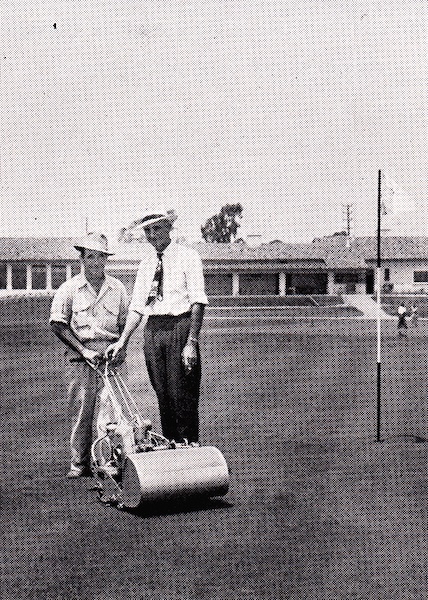
The Recreation and Park Department held their official municipal opening on Friday, July 8, 1949. The next day the new course hosted the 24th U.S.G.A. Public Links Championship ( July 9 to July 16).
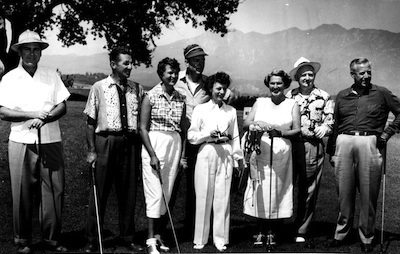
The Rancho Golf Course opened to the general public on July 17, 1949.
This page and all it’s contents are the property of J.I.B.Jones/GolfHistoricalSociety.org
© J.I.B.Jones/GolfHistoricalSociety 2014-2021
Golf Historical Society
Experts Rate Rancho Park Golf Course (1949)

Here is a group of Southern California golf legends posing on the 10th tee of the new Rancho golf course, on that magic day in 1949 when they first rated the course!
An article from the Los Angeles Times from March 24, 1949:
The new Rancho golf course received its baptism of fire yesterday when eight local links expert tested the course for the first time.
The purpose of their play was to give the course a handicap par rating and also to list the holes in order of difficulty for the score cards. The course will not be opened officially until it is the scene of the National Public Links championship July 11-16. The links will be available for public play following that time.
Wille Hunter, pro at Riviera, and Johnny Dawson, Lakeside amateur, scored 70s yesterday. Harold Dawson, executive secretary of the Southern California Golf Association, and a 7-handicap golfer, scored a 77. J.C. Cunningham, a public links official and a 12 handicapper, scored 82 and Bill Johnson, L.A. city golf course manager, a 16 handicapper, had 87.
Others in the group did not play full rounds. They were Maurie Luxford, president of the City Recreation and Park Commission; George Von Elm and Golf Architect Billy Bell.
Course Rated
Johnny Dawson gave the course a par rating of 70.9 and Harold Dawson rated it 70.7. The actual par will be 71. The second hole, 445-yard 4-par, was judged the most difficult and the 16th, a 179-yard 3-par, rated the easiest.
Rancho, at Pico Blvd. and Patricia Ave., is on the site of the old Rancho course, which has been closed for several years.
Transcribed by J.Jones, Rancho Park Golf Club historian.
1949 Rancho Golf Course Opening Score Card
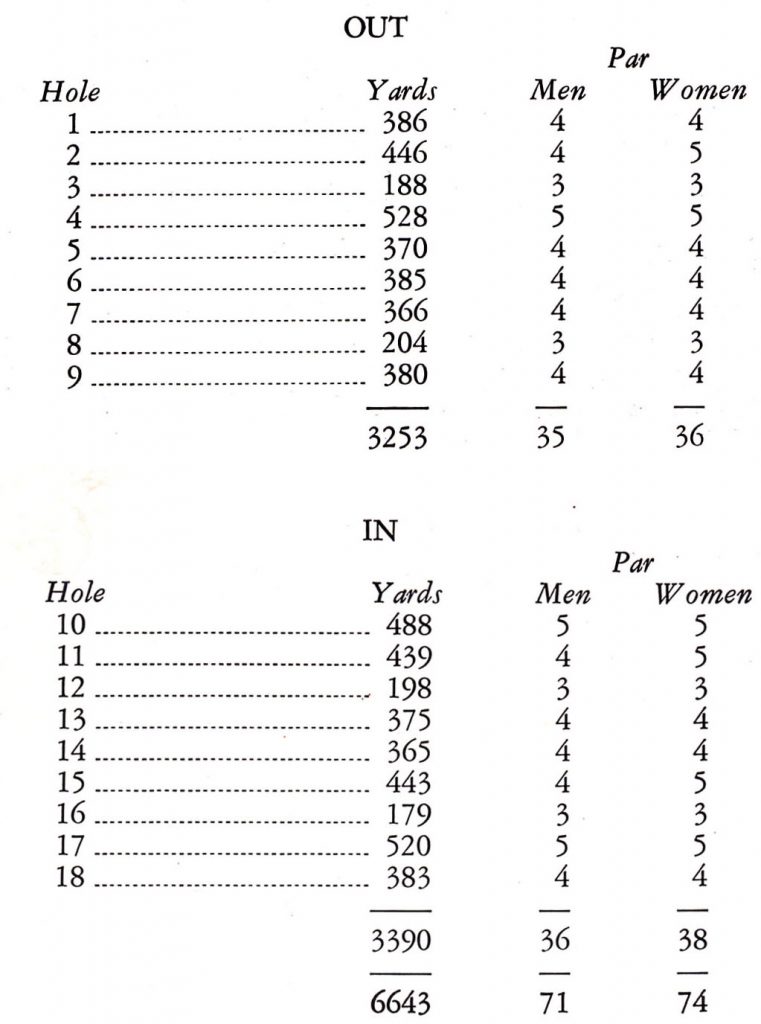
© 2018 golfhistoricalsociety.org & J.I.B. Jones.
A New Arnold Palmer Plaque Dedicated at Rancho Park Golf Course
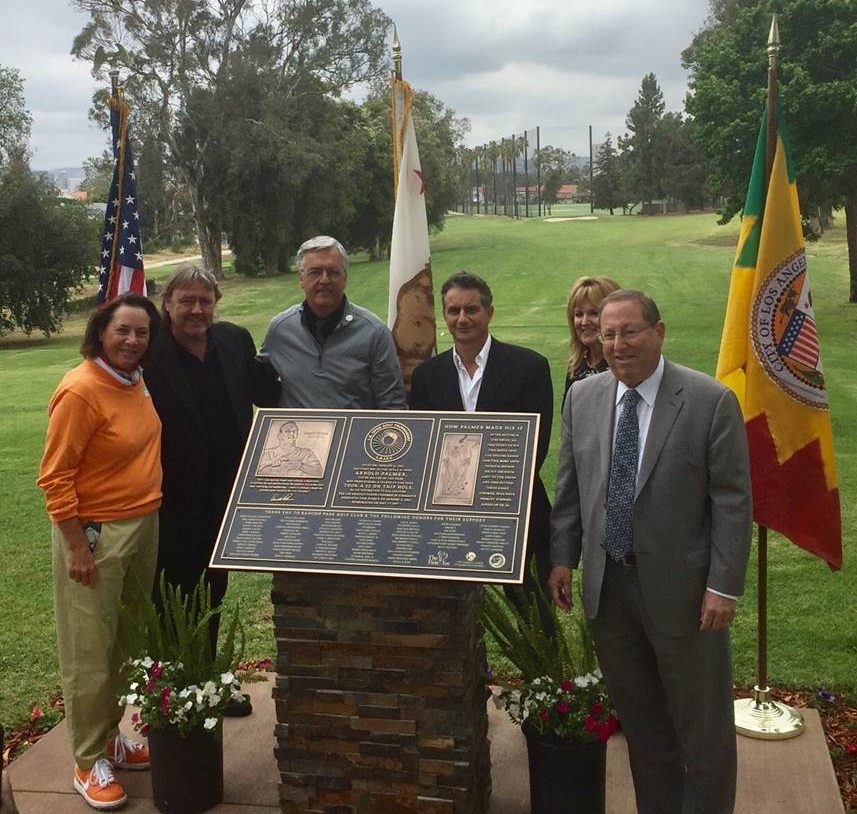
On Wednesday last, a new Arnold Palmer plaque was dedicated, commemorating his score of 12, on Rancho Park’s par-five 18th hole, during the first round of the 1961 L.A. Open. The original plaque was dedicated in 1963, and later stolen. A replacement “stone” was installed by the Recreation and Parks Department.
This beautiful new plaque, designed by graphic artist and Rancho Park golf club champion, Ed Passarelli, is the permanent replacement, being a combination of a re-creation of the original plaque, plus a map of the hole, with a description of the strokes taken by Mr Palmer, plus an embossed photograph.
The idea for replacing the replacement of the original plaque, and the execution of the plan to use it to raise money for junior golf, was all Phil Baugh, of the First Tee of Los Angeles.
Arnold would be proud.
After her speech, golf legend Amy Alcott, tee’d up a ball, and played the 18th hole, with a gallery of supporters and guests, she made some beautiful strokes, easily scoring a par 5, with never an inclination of the “heart warming” 3-woods that Arnold experienced in January 1961!
From left to right in the photo:
- Amy Alcott – LPGA & World Golf Hall of Fame member
- John Jones – Rancho Park GC Historian & Grammy Award winner
- Phil Bough – ED LAJCC Charity Foundation/The First Tee of Los Angeles
- Ed Passarelli – Plaque Designer
- Laura Bauernfiend – Golf Manager, LA City Rec. & Parks
- Paul Koretz – LA Councilmember, 5th District
